小学英语教科版(广州)四年级上册全册 教案
- 格式:pdf
- 大小:664.29 KB
- 文档页数:56
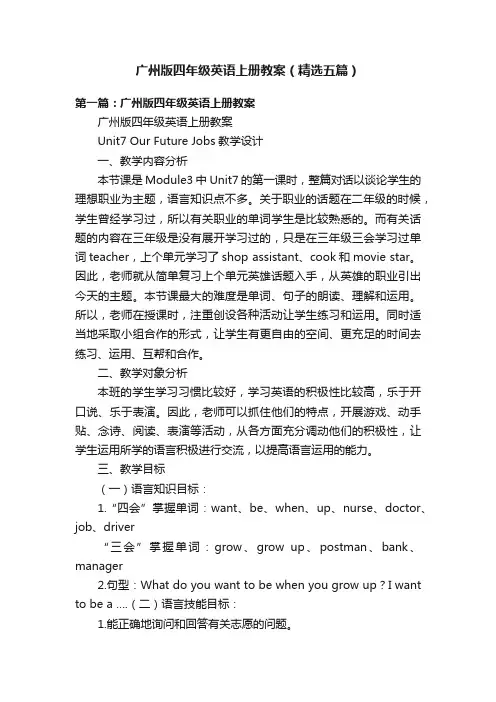
广州版四年级英语上册教案(精选五篇)第一篇:广州版四年级英语上册教案广州版四年级英语上册教案Unit7 Our Future Jobs教学设计一、教学内容分析本节课是Module3中Unit7的第一课时,整篇对话以谈论学生的理想职业为主题,语言知识点不多。
关于职业的话题在二年级的时候,学生曾经学习过,所以有关职业的单词学生是比较熟悉的。
而有关话题的内容在三年级是没有展开学习过的,只是在三年级三会学习过单词teacher,上个单元学习了shop assistant、cook和movie star。
因此,老师就从简单复习上个单元英雄话题入手,从英雄的职业引出今天的主题。
本节课最大的难度是单词、句子的朗读、理解和运用。
所以,老师在授课时,注重创设各种活动让学生练习和运用。
同时适当地采取小组合作的形式,让学生有更自由的空间、更充足的时间去练习、运用、互帮和合作。
二、教学对象分析本班的学生学习习惯比较好,学习英语的积极性比较高,乐于开口说、乐于表演。
因此,老师可以抓住他们的特点,开展游戏、动手贴、念诗、阅读、表演等活动,从各方面充分调动他们的积极性,让学生运用所学的语言积极进行交流,以提高语言运用的能力。
三、教学目标(一)语言知识目标:1.“四会”掌握单词:want、be、when、up、nurse、doctor、job、driver“三会”掌握单词:grow、grow up、postman、bank、manager2.句型:What do you want to be when you grow up?I want to be a ….(二)语言技能目标:1.能正确地询问和回答有关志愿的问题。
2.能理解课文意思,用正确的语音语调流利地朗读课文并表演课文。
(三)学习策略目标通过课文的学习,提高学生自主学习的能力。
同时,通过小组活动提高学生与人交流合作的能力。
(四)情感态度目标1.通过各种活动让学生体现学习的乐趣,从而增强英语学习的信心。
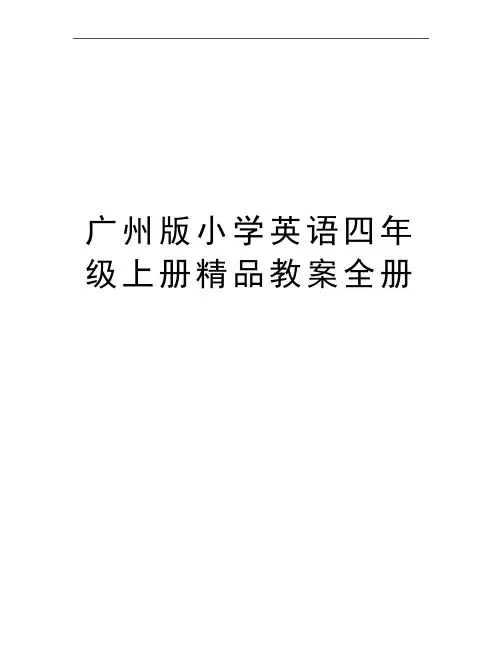
广州版小学英语四年级上册精品教案全册广州版小学英语四年级上册精品教案全册Module 1 ClothesUnit 1 Buying ClothesUnit 2 Different ClothesUnit 3 DevelopmentModule 2 PeopleUnit 4 FriendsUnit 6 DevelopmentUnit 5 Our Heroes And HeroinesModule 3 OccupationsUnit 7 Our Future JobsUnit 8 My family members’ jobsUnit 9 DevelopmentModule 4 People Who Help UsUnit 10 The New NeighboursUnit 11 They Can Help UsModule 5 TimeUnit 13 Our ArrangementUnit 14 Time to go to schoolUnit 15 DevelopmentModule 6 Days of the weekU16 Games we playRevision ⅠⅡⅢLong-Term ObjectivesSuccess with English aims to help pupils to achieve the following objectives: ●To enjoy learning English;●To be motivated to learn English;●To become independent learners and users of English;●To want to be able to continue learning English after the course;●To become accurate users of English;●To become fluent users of English;●To become appropriate users of English;●To become effective users of English;●To become effective listeners of English;●To become effective speakers of English;To become effective writers of English.Module 1 ClothesI. Objectives(目标)1. Language skill (Listening speaking reading writing)(1) know about clothes in English(2) can talk about clothes and ask the price of the clothes I want to buy.2. Language knowledge(1) Vocabulary:4 skills: shirt, blouse, dress, skirt, coat, pair, a pair of …., shoe, shorts, shop, can, help,I’d like to buy… much, h ow much, yuan, forth, them, twenty, thirty, fifty,eighty, hundred, T-shirt, sock, pound, whose3 skills: clothes, jacket, sweater, trousers, jeans, assistant, shop assistant, take, I’ll takeit, sport, sport shoe, sir, bye, madamDrills(2) * Can I help you, sir / madam?* I’d like to buy a pair of shoes.* How much is the T-shirt?* It’s twenty yuan.* How much are the trousers?They’re forty pounds.* Whose is the coat?It’s John’s.* Whose are the long socks?They’re my sister’s.(3) sub-topic:Unit 1: Buying clothesUnit 2: Different clothesUnit 3: Development3. Affect(1) To give pupils chances to share their knowledge.(2) To increase pupils’ confidence & self-esteem(3) To provide challenges(4) To have fun(5) To develop cultureal awareness(6) To open the pupils’ minds(7) To promote imagination4. Learning Strategy(1) Cognitive strategy(2) Regulating strategy(3) Communicative resource strategy5. Cultural Consciousness(1) The Eskimo woman wears her fur coat in winter in order to keep warm.(2) The Japanese woman wears her kimono at ceremonies because it’s traditional.(3) The African woman wears her grass skirt when she is dancing. This is because it’straditional and it keeps her cool.II. focal points:1.Can I help you sir / madam?2.I’d like to….3.How much is / are…?It’s / They’re…4.Whose is / are…?III. Difficult pointsage of “a pair of ….”2.Practice in numerals.IV. Schedule: 8 long-periodsV. Materials: Textbook, Activity book, Tapes, Teacher’s book, word cards.Unit 1 Buying ClothesI. Subjects1. vocabulary:can, help, buy, much, yuan, dress (4 skills)shop assistant, clothes, take (3 skills)2. Can I help you? I’d like to buy….How much is it? It’s….3. Culture: “yuan”——外来语,单复同形II. Focal and difficult pointsCan I help you? I’d like to….How much is it? It’s…I’ll take itIII. Processes1. Leading inA. Review numeralsTen, twenty… ninety →ninety yuan (show) “yuan” 外来语,单复同形 B. P1 T: Guess! Which one is worth 90 yuan?Yes, the dress. (教dress pl dresses)2. PresentationA. P2 T: Now, the woman is shopping at the shop.→ T分饰两角,重复对话两次配合动作让生了解对话。
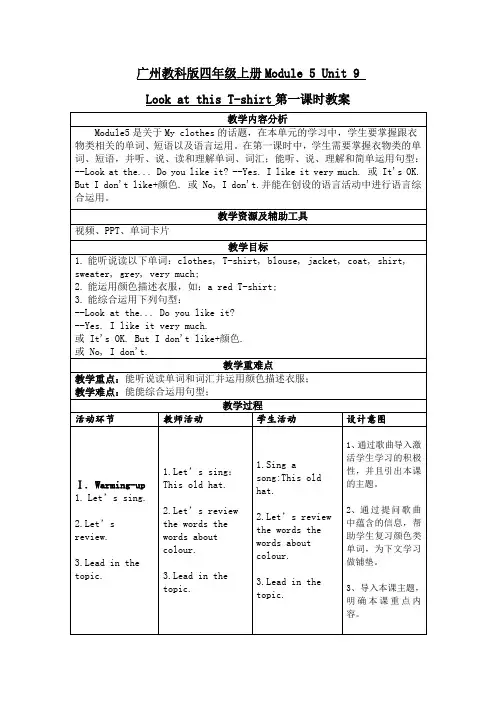
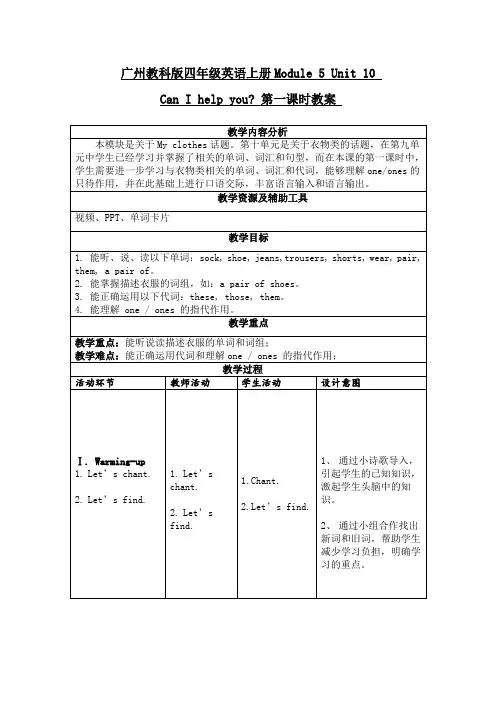
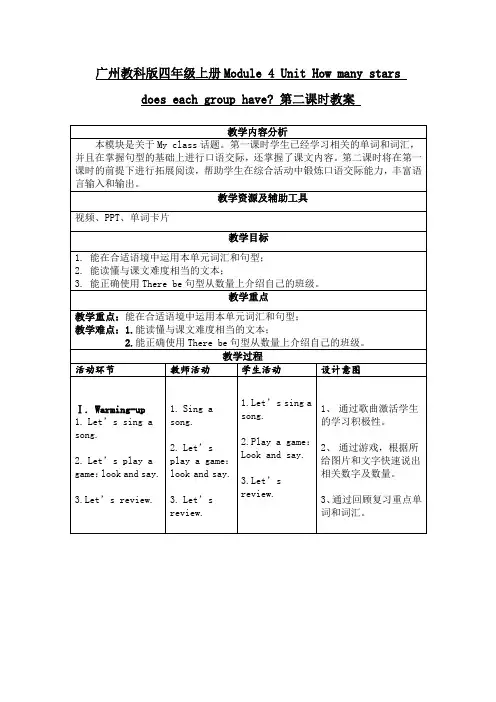
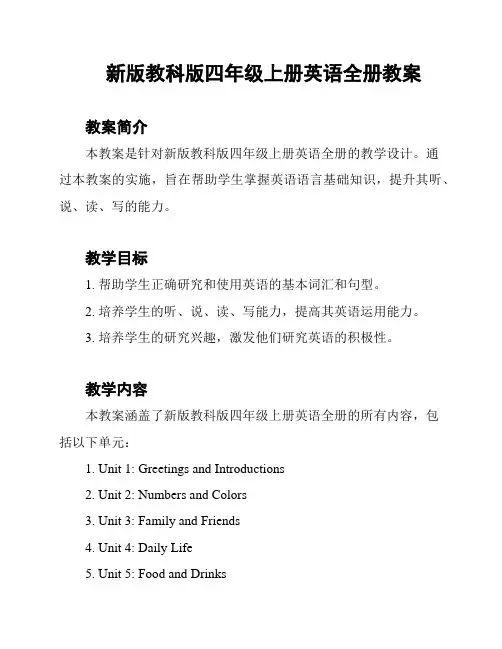
新版教科版四年级上册英语全册教案教案简介本教案是针对新版教科版四年级上册英语全册的教学设计。
通过本教案的实施,旨在帮助学生掌握英语语言基础知识,提升其听、说、读、写的能力。
教学目标1. 帮助学生正确研究和使用英语的基本词汇和句型。
2. 培养学生的听、说、读、写能力,提高其英语运用能力。
3. 培养学生的研究兴趣,激发他们研究英语的积极性。
教学内容本教案涵盖了新版教科版四年级上册英语全册的所有内容,包括以下单元:1. Unit 1: Greetings and Introductions2. Unit 2: Numbers and Colors3. Unit 3: Family and Friends4. Unit 4: Daily Life5. Unit 5: Food and Drinks6. Unit 6: Animals7. Unit 7: Sports and Hobbies8. Unit 8: Weather and Seasons教学活动教学活动的设计旨在帮助学生通过各种互动方式参与教学,激发他们的研究兴趣和积极性。
根据具体单元的内容,教学活动包括但不限于:1. 听录音并跟读2. 进行角色扮演对话3. 完成配对练和填空题4. 单词拼写和句子造句练5. 研究歌曲和儿歌6. 进行小组合作活动教学评估教学评估旨在帮助教师对学生的研究情况进行了解和评价,以便及时调整教学策略。
评估方式包括但不限于:1. 听力测试2. 口语表达能力评估3. 读写能力测试4. 小组合作成果评价教学资源教学资源是教师辅助教学的工具和材料。
教学资源包括但不限于:1. 教科书2. 录音机或电脑3. PPT或教学投影仪4. 单词卡片和图片5. 研究歌曲和儿歌的音频以上是新版教科版四年级上册英语全册教案的简要概述。
通过合理的教学设计和活动安排,希望能够帮助学生在英语学习方面取得进步。
教师可以根据实际情况进行适当调整和拓展,以满足学生的各类学习需求。
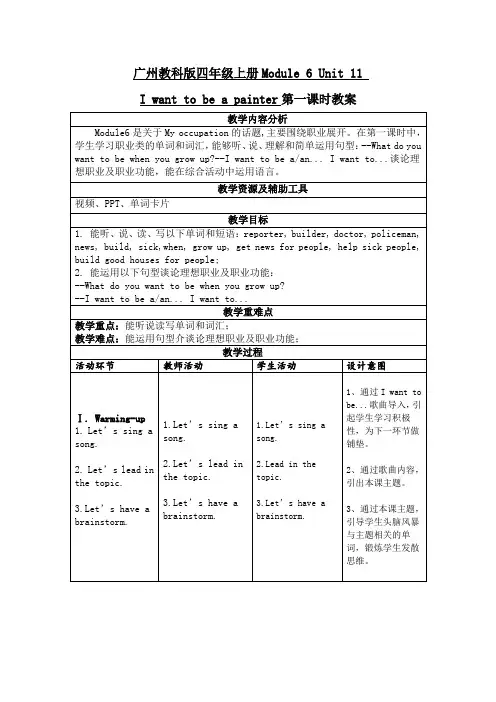
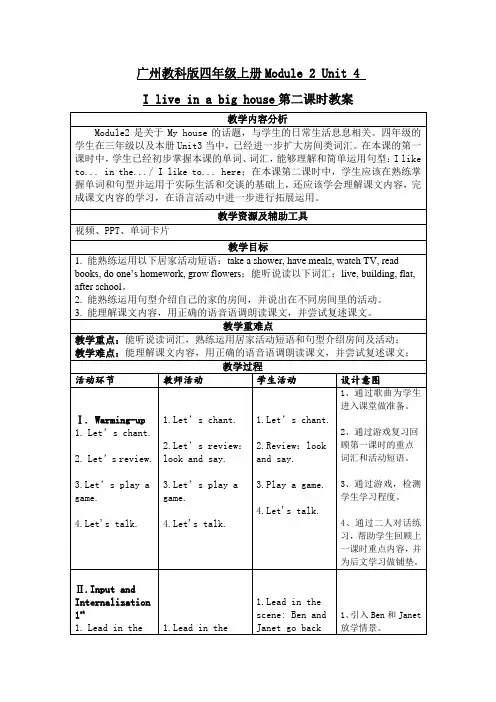
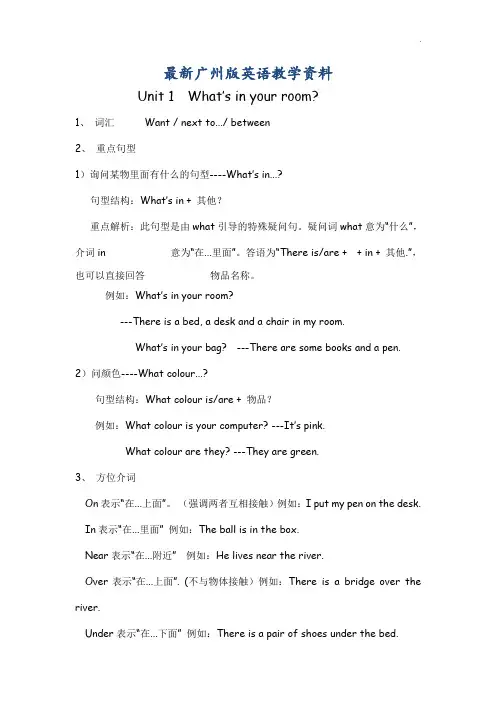
最新广州版英语教学资料Unit 1 What’s in your room?1、词汇Want / next to.../ between2、重点句型1)询问某物里面有什么的句型----What’s in...?句型结构:What’s in + 其他?重点解析:此句型是由what引导的特殊疑问句。
疑问词what意为“什么”,介词in 意为“在...里面”。
答语为“There is/are + + in + 其他.”,也可以直接回答物品名称。
例如:What’s in your room?---There is a bed, a desk and a chair in my room.What’s in your bag? ---There are some books and a pen. 2)问颜色----What colour...?句型结构:What colour is/are + 物品?例如:What colour is your computer? ---It’s pink.What colour are they? ---They are green.3、方位介词On表示“在...上面”。
(强调两者互相接触)例如:I put my pen on the desk. In表示“在...里面” 例如:The ball is in the box.Near表示“在...附近” 例如:He lives near the river.Over表示“在...上面”. (不与物体接触)例如:There is a bridge over the river.Under表示“在...下面” 例如:There is a pair of shoes under the bed.Behind表示“在...后面” 例如:There is a river behind the house.In front of表示“在...前面” 例如:There is a big tree in front of the house. Next to...在旁边例如:There is a bed next to the window.Between 在(两者)之间例如:There is a chair between the door and the window. 4、语法:be动词的用法和区别there be句型和have/has的用法区别一、Be动词Be动词:am、is、are口诀:我用am, 你用are, is用在他她它,复数全用are。
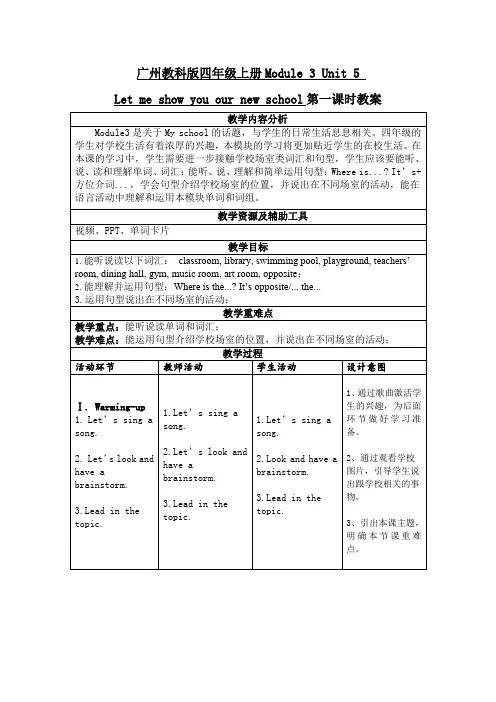

Unit 1 What’s in your room?1、词汇 Want / next to.../ between2、重点句型1)询问某物里面有什么的句型----What’s in...?句型结构:What’s in + 其他?重点解析:此句型是由what引导的特殊疑问句。
疑问词what意为“什么”,介词in 意为“在...里面”。
答语为“There is/are + + in + 其他.”,也可以直接回答物品名称。
例如:What’s in your room?---There is a bed, a desk and a chair in my room.What’s in your bag? ---There are some books and a pen.2)问颜色----What colour...?句型结构:What colour is/are + 物品?例如:What colour is your computer? ---It’s pink.What colour are they? ---They are green.3、方位介词On表示“在...上面”。
(强调两者互相接触)例如:I put my pen on the desk. In表示“在...里面”例如:The ball is in the box.Near表示“在...附近”例如:He lives near the river.Over表示“在...上面”. (不与物体接触)例如:There is a bridge over the river. Under表示“在...下面”例如:There is a pair of shoes under the bed.Behind表示“在...后面”例如:There is a river behind the house.In front of表示“在...前面”例如:There is a big tree in front of the house. Next to...在旁边例如:There is a bed next to the window.Between 在(两者)之间例如:There is a chair between the door and the window.4、语法:be动词的用法和区别there be句型和have/has的用法区别一、Be动词Be动词:am、 is、 are口诀:我用am, 你用are, is用在他她它,复数全用are。
英语精品资料广州版Unit 1 What’s in your room?1、词汇Want / next to.../ between2、重点句型1)询问某物里面有什么的句型----What’s in...?句型结构:What’s in + 其他?重点解析:此句型是由what引导的特殊疑问句。
疑问词what意为“什么”,介词in 意为“在...里面”。
答语为“There is/are + + in + 其他.”,也可以直接回答物品名称。
例如:What’s in your room?---There is a bed, a desk and a chair in my room.What’s in your bag? ---There are some books and a pen.2)问颜色----What colour...?句型结构:What colour is/are + 物品?例如:What colour is your computer? ---It’s pink.What colour are they? ---They are green.3、方位介词On表示“在...上面”。
(强调两者互相接触)例如:I put my pen on the desk.In表示“在...里面” 例如:The ball is in the box.Near表示“在...附近” 例如:He lives near the river.Over表示“在...上面”. (不与物体接触)例如:There is a bridge over the river.Under表示“在...下面” 例如:There is a pair of shoes under the bed.Behind表示“在...后面” 例如:There is a river behind the house.In front of表示“在...前面” 例如:There is a big tree in front of the house.Next to...在旁边例如:There is a bed next to the window.Between 在(两者)之间例如:There is a chair between the door and the window. 4、语法:be动词的用法和区别there be句型和have/has的用法区别一、Be动词Be动词:am、is、are口诀:我用am, 你用are, is用在他她它,复数全用are。
M odule 1 Unit1 What’s in your room?教案教学内容:教育科学版小学英语4A Unit 1教学目标:1. 知识目标:正确听、说、读、写介词between,next to。
2. 能力目标:能用所学的介词描述自己卧室里的物体,及物品所处的方位。
3. 情感、文化目标:通过游戏、贴画等活动激发学生的兴趣培养学生英语口语能力和学习英语的自信心。
教学重、难点:1. 介词between,next to。
2. 询问颜色。
教学准备:单词卡、PPT、录音机。
教学过程:Part 1 问候与游戏1.问候T: Good morning, girls and boys. How are you?S: Nice to meet you. I’m happy, are you happy?T: Sit down, please.2.Play a game: I say you do.“我来说,你来做”老师发出指令,学生按老师的指令去做。
Point to a window.Point to the door.Point to a pink object.Point to a computer·····3.Draw a picture of your bedroom.Let Ss draw a picture of their bedrooms. Color the pictures. Then tell their classmates what are in their bedrooms.Part 2 讲授新概念1. 用一个物品来演示beside,above,below,between和next to这些方位介词的意思,鼓励学生大胆说出这些词的意义。
当学生在说这些词的意义时,老师用物品表演相应的动作。
解释between和next to这种新概念的意思。
四年级英语上册全册教案(新版广州版)Unit10 Can I help you?一、教学目标(1)知识目标1,能听懂、会说、初步认读衣服类单词:sweater,T-blouse,做到发音准确。
2,能听懂、会说Can I help you?并用I’d like …作出回答。
3,通过Good to known. 让学生慢慢懂得讲礼貌的重要性。
(2)能力目标1,能在实际生活中运用英语表达熟悉和喜爱的衣服。
2,培养学生根据情景正确运用语言的能力。
(3)情感态度目标1,在活动中培养学生的协作精神。
2,培养学生认真、积极、大胆的学习态度。
3,学生慢慢懂得了讲礼貌的重要性。
除了在购物时要讲礼貌,我们要在任何时间任何地点都要讲礼貌,讲礼貌还体现在相互帮助相互团结上,上一阶段日本大地震,在地震中我们看到了人与人之间的相互帮助相互团结,都在尽所能帮助需要帮助的人们。
二、教学重难点1,能听懂、会说、初步认读衣服类单词:sweater,T-blouse,提高学生对单词的听、说、认、读能力。
2,听懂、会说Can I help you?并用I’d like …作出回答。
通过活动复习巩固本单元的重点句型,让学生能灵活的运用所学的句型进话。
引导学生用完整的英语句子来表达自己的观点,提高学生对句子的组织能力和运用语言的能力,以及对知识的拓展能力。
三、课前准备教材,练习纸,水果类、玩具类以及衣服类的图片单词卡片,PPT课件,网络等。
四、教学步骤: Warm-up and review(1)GreetingT: Good morning ,boys and girls!S: Good morning,Miss Xu!T(教师边说边做动作):In class,we should do eye,S:look;T:ear, S:listen;T:mouth, S:say(2)Ask and answT:Look awords:how and what.Now I’ll ask you some quT:How are you?S:I’ank you.T:What do you like?S1:I like applT:What can you see?S2:I can see a pencil.(3)Count numbT:Let’scouumbwelv:One,two,…twelve.T:Ok,well done.Tlet’s see what’s the number? S:Three.(课件中通过快闪方式呈现以下数字7,9,5)2: Presentation and pra(1)呈现王兵生日,引入主题。